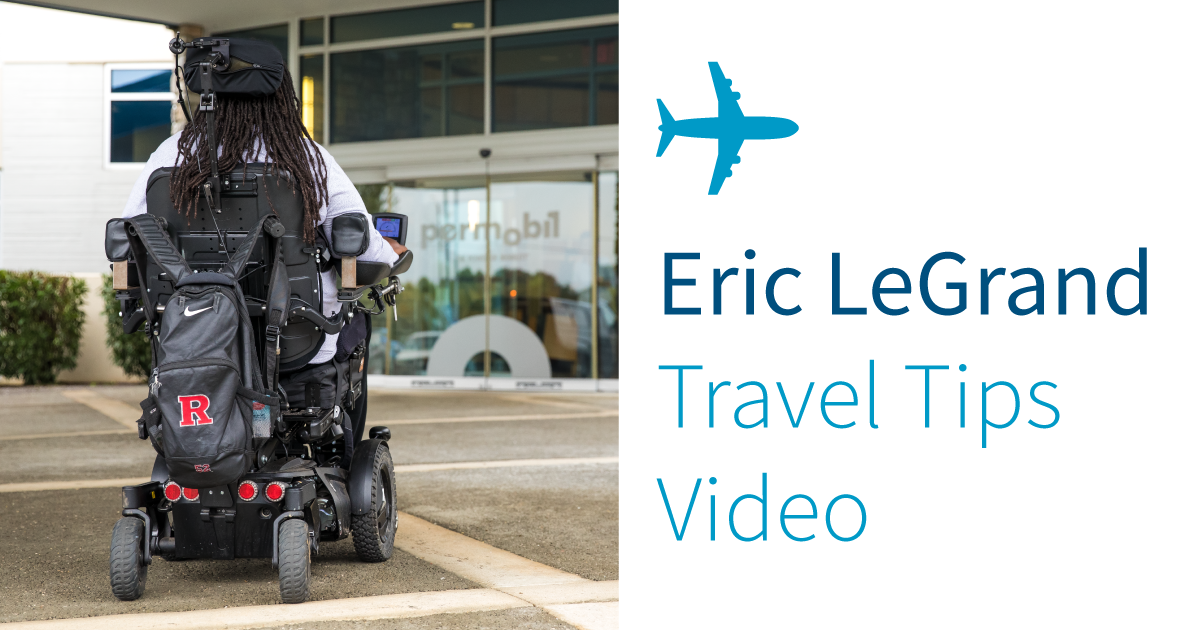As summer is fast approaching, traveling for vacation while in a wheelchair can be really stressful. We've worked with Eric LeGrand to come up with some wheelchair travel tips to follow while traveling.
Eric LeGrand's Story
Eric LeGrand is a former Rutgers University football player who suffered a severe spinal injury during a game on October 16th, 2010. LeGrand fractured his C-3 and C-4 vertebrae during a collision against an opposing player. He was taken to the Hackensack University Medical Center and underwent nine hours of emergency surgery. Eric was transferred to the Kessler Institute for Rehabilitation, one of the nation's leaders in spinal cord rehabilitation. By 2011, Eric had regained movement in his shoulders and sensation throughout his body.
Today Eric travels the country as a sought after motivational speaker and dedicates his time towards raising money for his charity Team LeGrand of the Christopher & Dana Reeve Foundation. Proceeds go toward research to find a cure for paralysis and helping improve the quality of life for people with spinal cord injuries.
Eric has been a Permobil client since his injury where he started out in a C500 and is now using a F5. Eric also helped with initial beta testing of the F-series back in 2015.
Watch the Tips for Wheelchair Traveling video below. Wishing you safe and stress-free travels this summer and beyond!
Video Transcript (edited for clarity):
Hi, my name is Eric LeGrand. I’m a former Rutgers football player who was spinal cord injured on October 16, 2010, and I’m here to talk to you about tips of wheelchair traveling.
Preparing for Your Trip
The first thing I consider when I decide to take a trip is looking at the size of the airplane that I’m going to have to get on with my wheelchair. I go about preparing my chair for travel; we use a lot of bubble wrap when it comes to preparing my chair. We take my headrest off, and we put it in the seat of the chair and wrap it around. We also wrap the Omni so it doesn’t get hit by any luggage or anything when it goes into the cargo hold.
When I book the flight that I’m eventually going on, I also have to explain the type of chair that I have, whether it’s a dry or wet celled battery, and if it’s a manual chair or a power chair.
One of the most important things to remember to pack is your chair battery charger. You do not want to get to your destination or wherever you’re going and forget to have your charger because then you won’t be able to get around and see the things you want to see.
Make a checklist on either a big piece of paper or cardboard on your chair so the people that are handling your chair like the ramp supervisor and everyone else that’s below the cargo hold will be able to look at it and know how to move the chair and how to take it in and out of gear. If you give them a checklist to go by everything goes smoothly.
At the Airport
When I first arrive at the airport, I always contact the person at disability services that I’m about 5-10 minutes out, so they can meet me at one of the gates. Once I get to the airport, I get the boarding passes at the check in desk. Usually they have someone check my bags, and I let them know what medical equipment I have so they can tag anything that’s fragile. Be sure to let them know right away.
When you get to the security gate, go to the front of the line. Usually someone will escort you to the front.
The first thing I do when I get to my gate is I go right up to the gate manager and ask for them to send up the ramp supervisor. Once they send up the ramp supervisor, I explain to them how to take care of my chair along with the checklist of taking care of my chair and stress how important it is to not drop my chair.
Getting On and Off the Airplane
About 10-15 minutes before the whole plane is supposed to board, that is when you board. The disability service will come down and they bring you into the jetway and that’s when you’ll transfer from your chair to an aisle chair. Be an advocate for yourself when you’re getting on a plane. You have to tell them what works for you because that might not work for someone else. Make sure you’re 100% comfortable. I would recommend bringing a cushion onto the plane to prevent any type of pressure injuries, or if you have the ability to do weight shifts yourself being able to do that is a huge thing while you’re on the plane.
Congratulations!
You guys have now reached your destination. Through prior arrangements, you will have the disability service people coming onto the plane with the aisle chair to lift you from your seat to the aisle chair. Meanwhile your chair will be getting unloaded from the plane and brought up to you in the jetway.
Once you’re back in your chair, inspect your chair to make sure nothing was broken and they took care of it the proper way. Now if something unfortunate was to happen to your chair, before you leave the airport make sure you get a claim number and let the people there know what happened. Remain calm because there’s always hiccups in everybody’s trip. When you’re dealing with the personnel make sure you treat them with respect, educate them, and advocate for yourself. At the end of the day, be happy and enjoy your trip.

